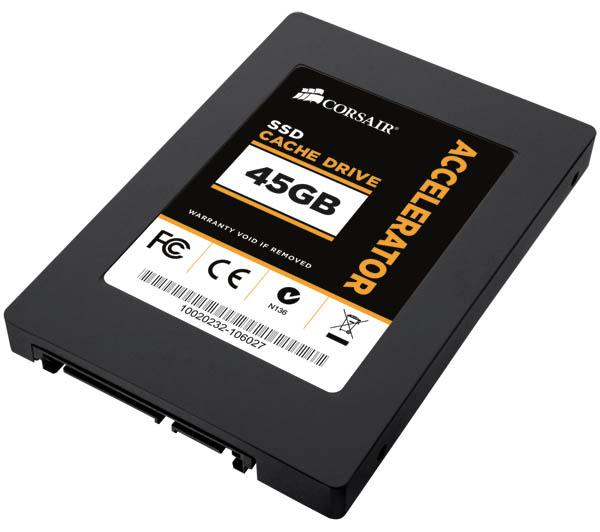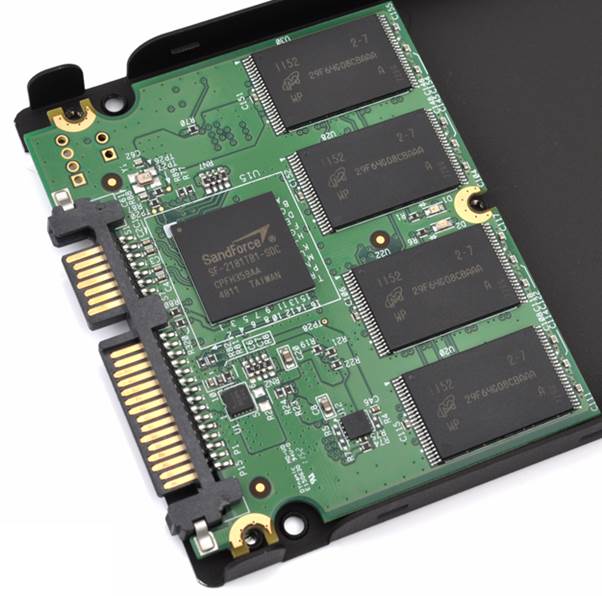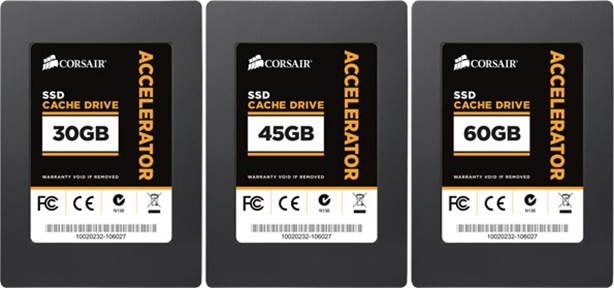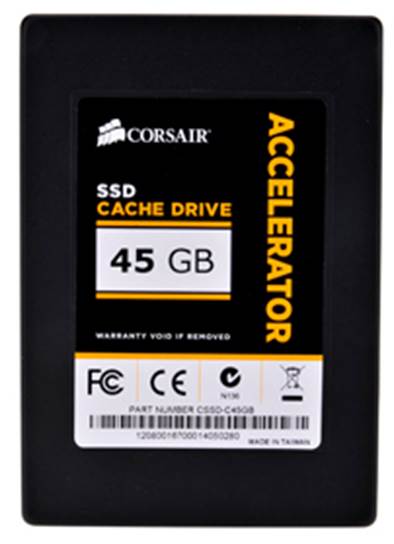Corsair offers its Accelerator drive in
three versions, with this 45GB model sitting in the middle of the range. The
baby 30GB costs $64, this 45GB is $80 and the largest 60GB drives costs $97.

Corsair
Accelerator 45GB
The form factor of the Accelerator looks
outwardly similar to a regular Corsair 2.5" SA TA SSD. When you pop the
two halves of the casing apart, you can see that the PCB is only 50mm long,
presumably to reduce the cost of materials to a minimum.
The PCB is secured with three screws, and
when you pull the board from the casing you can see the SandForce SF-2281
controller chip. There are spaces for four flash chips on each side of the
board and our 45GB drive uses six chips. Common sense says the others models
use four and eight chips respectively.

The
PCB is secured with three screws, and when you pull the board from the casing
you can see the SandForce SF-2281 controller chip.
Once the drive is installed, you have to go
through a bit of a pantomime before you can download the Dataplex caching
software. Follow the web link and you'll have to enter the 28-character serial
number that's printed on the bar code on the body of the drive. We were very
pleased with ourselves when we saw we had typed the code correctly. With the
downloaded file on the hard drive, we installed the Accelerator SSD in the case
and checked for a firmware update for the Corsair. This is a painful process,
because you have to visit the Corsair forums to check the latest firmware for
your SSD, instead of simply going to the relevant product page. Next, you
download the Corsair Firmware Update tool along with a folder of firmware files
for your particular drive, although in fairness the actual process of updating
the firmware was both quick and easy.
Once the firmware had been updated from
version 1.3.4 to v5.03, we installed the Dataplex software and found that we
had to type in the 28-character code all over again. That was frustrating.

You
can only use this software on Windows 7 (and presumably Windows 8) but not in
Max OS X, Linux or Windows XP.
There are other problems connected with the
Dataplex Nvelo software that are significant. You can only use this software on
Windows 7 (and presumably Windows 8) but not in Max OS X, Linux or Windows XP.
The second problem is that the software won't work with a main hard drive that
uses a GPT partition and must use MBR. In the past this simply wasn't an issue,
because every PC hard drive used MBR, but the rise of 3TB and 4TB hard drives
means that you may well be using GPT without even being aware of the fact.
On the plus side, there's no need to set
the BIOS to RAID (as you have to when you use Intel RST), so provided your hard
drive isn't partitioned with GPT, that you use Windows 7 and can type in your
serial number correctly, you'll manage the job easily enough.

We
liked the Corsair Accelerator, but this came as no surprise when you consider
Corsair's solid history of delivering products that perform well at a reasonable
price.
Configuring the Dataplex software is pretty
much a one-click operation. You have to confirm which is your main drive and
which is the cache drive, and that's the end of the matter. Restart the PC,
observe that the Corsair drive has magically vanished from view and get on with
using the system.
As the Dataplex software caches files, the
system speed increases appreciably and in particular system start-up becomes
much brisker.
We liked the Corsair Accelerator, but this
came as no surprise when you consider Corsair's solid history of delivering
products that perform well at a reasonable price.
The biggest issue that we have is the minor
snags in the area of usability. The firmware update process could be slicker
and the Dataplex caching software would benefit from an overhaul.
Other than that we like the Corsair and
considered it to be a solid contender.
|
Details
·
Price: $80
·
Manufacturer: Corsair
·
Website: www.corsair.com
·
Required spec: Windows 7
Ratings
·
Quality: 7
·
Value: 8
·
Overall: 7
|